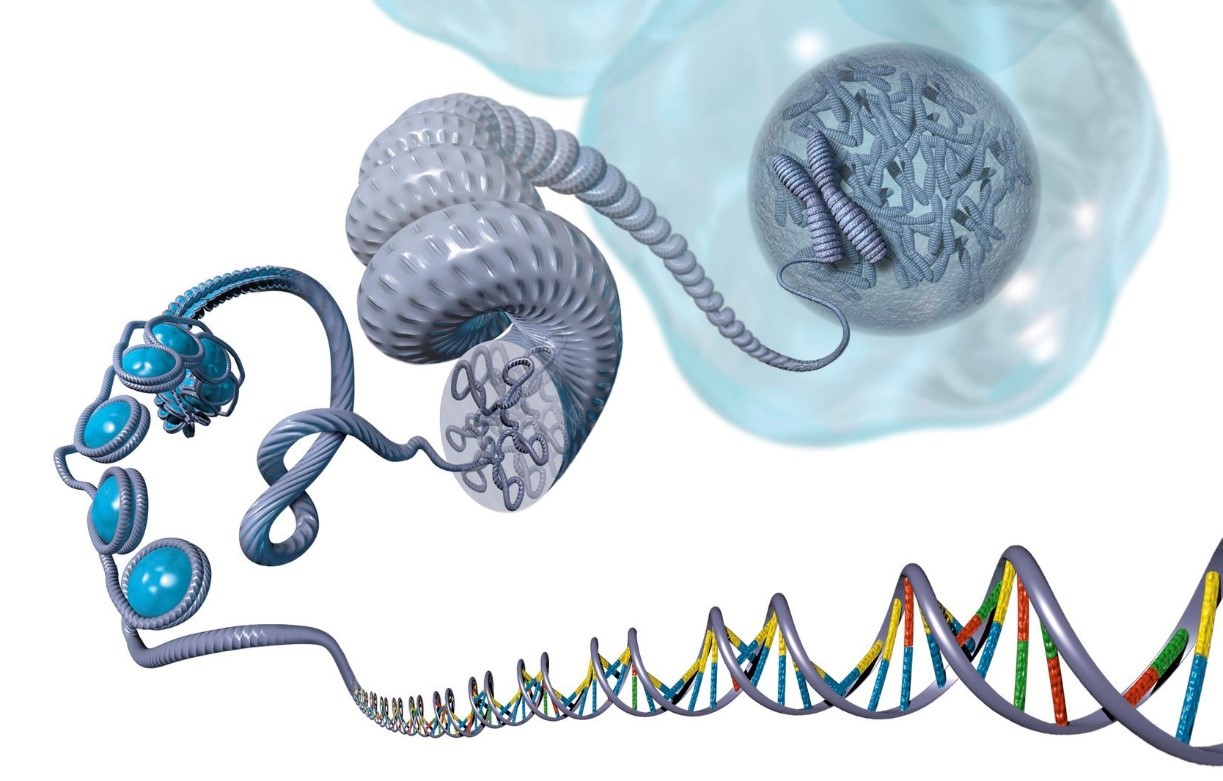
1) Definition
Our DNA contains the code for life, telling the cells in our body what to do. Not every cell in our body needs to do the same, so not every cell uses the same parts of the DNA. The cell determines which part of the DNA code to use by altering the chemical structure of the DNA. This is done through ‘epigenetics’, from the Greek word “epi”, meaning “on”. So we define epigenetics as chemical structures on the DNA, which regulate gene expression (i.e., which part of the DNA code will be used).
2) Examples
Not only does epigenetics differ in different cells, it also differs in different individuals. Epigenetics can be influenced by our surroundings. This means that our surroundings can influence the functioning of our cells! A very good example is tobacco exposure. Smoking can alter our epigenetics, and scientists have found that most of these changes are long-lasting [1]. However, quitting smoking can undo some of the epigenetic changes [2]. Stress and diet are other good examples that can alter epigenetics [3,4], and we explain this in one of our blogs: How Diet Influences Gene Expression – Eat2BeNice (newbrainnutrition.com)[5].
3) Inheritance
All these surrounding factors do not only influence your own epigenetics. Maternal smoking, toxin exposures, diet, and stress also influences the epigenetic programming of the unborn child. This mechanism prepares the child for the environment it is going to be born in, but often has negative effects on health [6]. Scientists have also shown that not only the epigenetics of people undergoing trauma, but also their offspring is altered [7]. This shows that mental health of the parent can have influence on the epigenetic health of their children. But is does not per se mean that epigenetics is heritable.
In short, epigenetics gives us some plasticity to adapt to our constantly changing surroundings. This means that we can partially control our own health by living as healthy as possible.
References
Image by Science Photo Library, NTB (Credits CC-BY-NC)
[1] Zeilinger, S., Kühnel, B., Klopp, N., Baurecht, H., Kleinschmidt, A., Gieger, C., Weidinger, S., Lattka, E., Adamski, J., Peters, A., Strauch, K., Waldenberger, M., & Illig, T. (2013). Tobacco smoking leads to extensive genome-wide changes in DNA methylation. PloS one, 8(5), e63812. https://doi.org/10.1371/journal.pone.0063812
[2] McCartney, D. L., Stevenson, A. J., Hillary, R. F., Walker, R. M., Bermingham, M. L., Morris, S. W., Clarke, T. K., Campbell, A., Murray, A. D., Whalley, H. C., Porteous, D. J., Visscher, P. M., McIntosh, A. M., Evans, K. L., Deary, I. J., & Marioni, R. E. (2018). Epigenetic signatures of starting and stopping smoking. EBioMedicine, 37, 214–220. https://doi.org/10.1016/j.ebiom.2018.10.051
[3] Klengel, T., & Binder, E. B. (2015). Epigenetics of Stress-Related Psychiatric Disorders and Gene × Environment Interactions. Neuron, 86(6), 1343–1357. https://doi.org/10.1016/j.neuron.2015.05.036
[4] Dolinoy, D. C., Weidman, J. R., Waterland, R. A., & Jirtle, R. L. (2006). Maternal genistein alters coat color and protects Avy mouse offspring from obesity by modifying the fetal epigenome. Environmental health perspectives, 114(4), 567–572. https://doi.org/10.1289/ehp.8700
[5] How Diet Influences Gene Expression – Eat2BeNice (newbrainnutrition.com)
[6] Li, S., Chen, M., Li, Y., & Tollefsbol, T. O. (2019). Prenatal epigenetics diets play protective roles against environmental pollution. Clinical epigenetics, 11(1), 82. https://doi.org/10.1186/s13148-019-0659-4
[7] Yehuda, R., Daskalakis, N. P., Bierer, L. M., Bader, H. N., Klengel, T., Holsboer, F., & Binder, E. B. (2016). Holocaust Exposure Induced Intergenerational Effects on FKBP5 Methylation. Biological psychiatry, 80(5), 372–380. https://doi.org/10.1016/j.biopsych.2015.08.005


